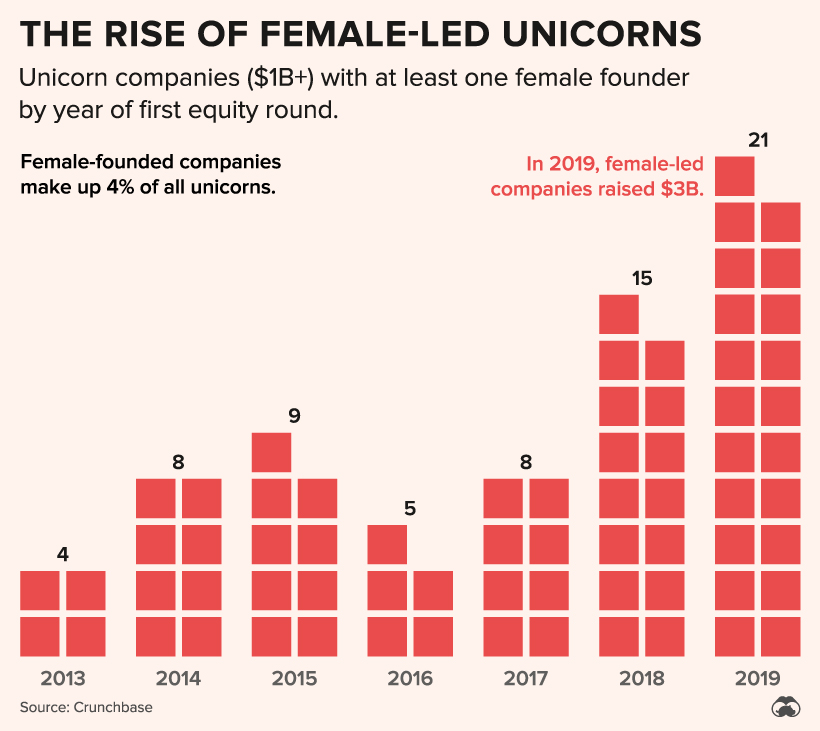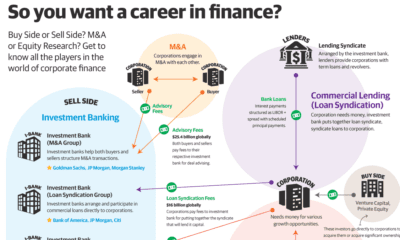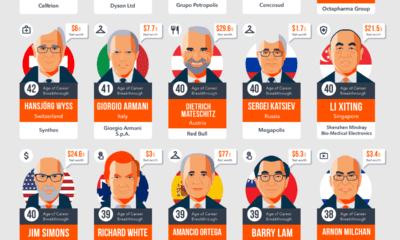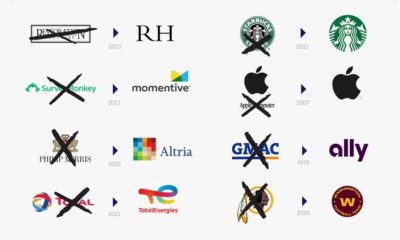Companies with at least one female founder generate 78 cents of revenue for every dollar of venture funding, while male-led startups generate roughly 31 cents. Yet, startups with only female founders receive just 3% of total invested dollars globally. The above infographic from Business Financing explores the global landscape of female-led startups. It shows the top female founders according to the highest amount of capital raised, in each country profiled.
Global Rankings: The Top 10 Female Founders
Which female founders have received the most funding worldwide? Based on data from Crunchbase, individuals were selected across 102 countries if they were a founder or co-founder of an active company as of May 21, 2020. Companies were selected depending on their status in seed, early stage venture, or late stage venture funding. With $22 billion in funding, Lucy Peng, co-founder of Ant Group and Alibaba tops the list. Peng taught economics for five years before co-founding Alibaba with 18 others in 1999. Today, she is worth over $1 billion. Peng’s 2.1% stake in Ant Group is estimated to be worth roughly $4.8 billion. Ant Group filed for an IPO worth an estimated $225 billion valuation in August 2020. Following Peng is Rebekah Neumann, who has raised $19.5 billion with The We Company. Neumann studied business with a minor in Buddhism at Cornell, and later co-founded the gig-focused firm in 2010 with her husband Adam Neumann and Miguel McKelvey. Following the notoriously disastrous IPO of WeWork, she and her husband have since left the company. Coming in third is Tan Hooi Ling who founded Grab in Singapore. The ride-hailing app is a major competitor of Uber in Asian markets. Cristina Junqueira, who co-founded digital banking firm NuBank, also makes it into the top 10 list. Currently, NuBank operates as the largest fintech firm in South America, with over 20 million users. Meanwhile, Lithuania’s first tech unicorn, Vinted was co-founded by Milda Mitkute and serves as the largest secondhand clothing platform worldwide.
Unicorns Bucking the Trend
While funding for female-led startups has been disproportionately low over the years, the number of unicorns—private companies valued in excess of $1 billion—headed by women has grown over fivefold. Since 2013, women-led unicorns have jumped from just four to 21 in 2019. While these numbers are still objectively quite small, they continue to climb.
Among the newly minted unicorns in 2019 was Airwallex, a company that allows businesses to track cross-border revenues. In April, the startup raised $160 million, valuing it at $1.8 billion. Along with Airwallex, Scale, Glossier and The RealReal are also found on the list.
New Waves of Venture Capital
In 2019, 2,300 venture deal rounds included startups with at least one female founder. Of these, a number of startups raised over $100 million in funding in 2019 on a worldwide level. Interestingly, funding data shows that women VCs are three times more likely than men to invest in women. This, coupled with the growing number of female partners at venture capital firms, is bringing a new perspective to tech financing. At the same time, it’s opening up new markets. For instance, the $57 billion child care industry is largely overlooked by the VC world. San Francisco-based Winnie raised $9 million in funding in 2019, capitalizing on a marketplace specifically for parents. Consumer products and markets focusing on solutions for women present areas of significant growth, particularly on a global level.
What’s Next For Female Founders?
While just a fraction of all venture funding is allocated to women-led companies, trends illustrate clear resilience. Female-founded firms continually outperform—and shareholder returns are only getting better every year. As both startup and venture capital ecosystems continue to evolve, the future of women-led entrepreneurship is as bright as ever. on But fast forward to the end of last week, and SVB was shuttered by regulators after a panic-induced bank run. So, how exactly did this happen? We dig in below.
Road to a Bank Run
SVB and its customers generally thrived during the low interest rate era, but as rates rose, SVB found itself more exposed to risk than a typical bank. Even so, at the end of 2022, the bank’s balance sheet showed no cause for alarm.
As well, the bank was viewed positively in a number of places. Most Wall Street analyst ratings were overwhelmingly positive on the bank’s stock, and Forbes had just added the bank to its Financial All-Stars list. Outward signs of trouble emerged on Wednesday, March 8th, when SVB surprised investors with news that the bank needed to raise more than $2 billion to shore up its balance sheet. The reaction from prominent venture capitalists was not positive, with Coatue Management, Union Square Ventures, and Peter Thiel’s Founders Fund moving to limit exposure to the 40-year-old bank. The influence of these firms is believed to have added fuel to the fire, and a bank run ensued. Also influencing decision making was the fact that SVB had the highest percentage of uninsured domestic deposits of all big banks. These totaled nearly $152 billion, or about 97% of all deposits. By the end of the day, customers had tried to withdraw $42 billion in deposits.
What Triggered the SVB Collapse?
While the collapse of SVB took place over the course of 44 hours, its roots trace back to the early pandemic years. In 2021, U.S. venture capital-backed companies raised a record $330 billion—double the amount seen in 2020. At the time, interest rates were at rock-bottom levels to help buoy the economy. Matt Levine sums up the situation well: “When interest rates are low everywhere, a dollar in 20 years is about as good as a dollar today, so a startup whose business model is “we will lose money for a decade building artificial intelligence, and then rake in lots of money in the far future” sounds pretty good. When interest rates are higher, a dollar today is better than a dollar tomorrow, so investors want cash flows. When interest rates were low for a long time, and suddenly become high, all the money that was rushing to your customers is suddenly cut off.” Source: Pitchbook Why is this important? During this time, SVB received billions of dollars from these venture-backed clients. In one year alone, their deposits increased 100%. They took these funds and invested them in longer-term bonds. As a result, this created a dangerous trap as the company expected rates would remain low. During this time, SVB invested in bonds at the top of the market. As interest rates rose higher and bond prices declined, SVB started taking major losses on their long-term bond holdings.
Losses Fueling a Liquidity Crunch
When SVB reported its fourth quarter results in early 2023, Moody’s Investor Service, a credit rating agency took notice. In early March, it said that SVB was at high risk for a downgrade due to its significant unrealized losses. In response, SVB looked to sell $2 billion of its investments at a loss to help boost liquidity for its struggling balance sheet. Soon, more hedge funds and venture investors realized SVB could be on thin ice. Depositors withdrew funds in droves, spurring a liquidity squeeze and prompting California regulators and the FDIC to step in and shut down the bank.
What Happens Now?
While much of SVB’s activity was focused on the tech sector, the bank’s shocking collapse has rattled a financial sector that is already on edge.
The four biggest U.S. banks lost a combined $52 billion the day before the SVB collapse. On Friday, other banking stocks saw double-digit drops, including Signature Bank (-23%), First Republic (-15%), and Silvergate Capital (-11%).
Source: Morningstar Direct. *Represents March 9 data, trading halted on March 10.
When the dust settles, it’s hard to predict the ripple effects that will emerge from this dramatic event. For investors, the Secretary of the Treasury Janet Yellen announced confidence in the banking system remaining resilient, noting that regulators have the proper tools in response to the issue.
But others have seen trouble brewing as far back as 2020 (or earlier) when commercial banking assets were skyrocketing and banks were buying bonds when rates were low.














